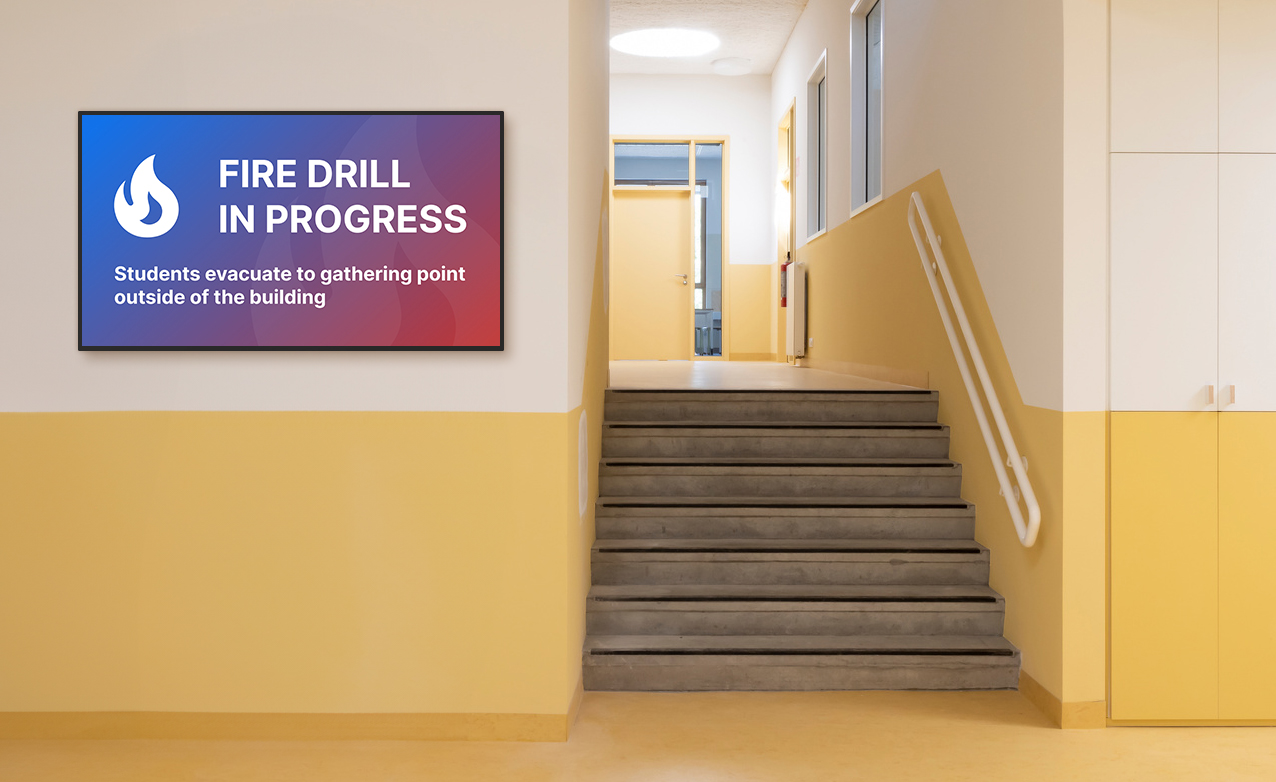
School districts must prepare for various emergencies with emergency plans for schools, including strategies, training, drills, and multi-faceted notification systems to protect individuals on campus from danger. Emergency alert systems are often at the heart of a notification strategy, serving as the primary method of informing students, teachers, staff, and visitors of an emergency on campus. A comprehensive system can also alert parents and other off-campus individuals of a situation before they enter the school.
While most schools rely on more than one emergency alert system as part of their school emergency plans, a 2022 survey from Campus Safety found that more than 10% of schools use six or more of these tools. A multi-faceted approach to emergency notifications is an excellent way to ensure your school district’s plans meet expectations. Consider adding a digital signage solution to your emergency response strategy to streamline your notification process. Digital signage can convey fast and concise information to individuals on campus. We will explore emergency plans for schools and how an emergency alert system fits in with digital signage as a seamless method of notifying the campus when required.
What is a multi-faceted emergency plan for schools?
A school emergency or operation plan aims to proactively and safely react to incidents if and when they occur. The method operates in five main areas: prevention, protection, mitigation, response, and recovery. It involves recognizing a hazard and developing strategies to minimize risk to individuals on the school campus. A school emergency plan should include nominating leadership to coordinate the crisis response and preparing with drills, training, and physical implementations—door locks, panic buttons, and school alert systems.
When developing an emergency plan, school districts need to consider the probability of situations they are preparing for and focus on the more likely incidents. It is also necessary for schools to avoid implementing drills and training that can cause unintended trauma. For instance, avert active shooter drills, as many professionals question their efficacy, and some states have prohibited such exercises by law due to the trauma they cause to students.
While a school can get by using a single emergency alert system, it can mean the difference between life and death when the situation calls for a multi-faceted approach. This emergency plan for schools combines several methods, techniques, and capabilities to provide an all-encompassing strategy to overcome emergencies while minimizing death, injury, and trauma. A multi-faceted plan can help your school overcome the following:
- Fires and evacuations
- Severe weather and natural disasters
- Gas leaks and hazmat spills
- Medical emergencies
- Fights and disturbances
- Lockdowns
- Bomb threats
- Active shooter situations
How can your district benefit from a multi-faceted notification system in its school emergency plans?
A multi-faceted emergency notification system provides several benefits over a single system. A school alert system can fail during a critical situation or issue a notification too slow to be effective. A comprehensive emergency alert system ensures that a campus can respond to a situation with consistent, fast, and equally accessible notifications to instruct students, visitors, teachers, and staff on what to do in an emergency. A 2020 survey from Campus Safety found that most campuses agree that multiple emergency alert systems are necessary, with 70% of the respondents using two or more alert systems and more than 20% using at least four.
A multi-faceted emergency plan can benefit your school district in the following ways:
- Redundancy: When one system fails, having at least one other emergency alert system ensures that the notification gets out to individuals on campus. Power failures, inaccessible public address (PA) rooms and single points of failure during a situation can endanger lives. An additional system or several ensures the alert can be issued.
- Response time: A fast response can save lives during an emergency. A multi-faceted alert system ensures that a notification is promulgated throughout the campus before individuals encounter harm.
- Accessibility: Having several emergency alert systems means that the school or district can issue powerful audio and video alerts and notifications throughout all areas of the campus. An ideal notification system can be seen and heard in every corner of the school, including restrooms, recreational areas, and parking lots. The alert should also be accessible to visitors and individuals entering the school as the warning is given.
- Clarity: An alert should be clear enough for all individuals to understand. For instance, will visitors to the school and new students know where the fire exits are or what to do during a lockdown? An emergency plan for schools should provide clear and concise directions for everyone to understand.
Related: Best Practices for Using an Emergency Alert System for Schools
How can digital signage enhance your district’s school emergency plans?
Adding digital signage to your district’s emergency plans for schools can enhance and round out your plan as a whole. It can be part of a multi-faceted approach that ensures a faster, more thorough response to emergencies of varying risk.
While there is no emergency, digital signage can display cafeteria menus, announcements, news, weather, current events, general information, maps, directories, or eye-catching content. The alert can be broadcast on digital signage in common areas and displays within classrooms, such as projectors, HD televisions, and interactive flat panels connected to a wireless screen mirroring solution.
Digital signage is accessible
In addition to being simple to implement, digital signage offers accessibility to everyone on campus and entering the campus area with displays located inside and outside the school. They can incorporate audio and video alerts and instructions to provide inclusive notifications that are easily understood and highly visible. For many students, teachers, and staff, it can become a habit to look at digital signage for announcements, news, and eye-catching content that informs and entertains individuals passing by.
Digital signage offers a clear and concise notification, including images, written instructions, and verbal instructions. Alerts can grab the users’ attention using audio tones, images, colors, and bold text fonts. Unlike SMS notifications and apps, the displays are out in the open and accessible to anyone without signing up or having a phone readily available.
Digital signage is flexible and fast
Digital signage is visible and accessible while offering a quick response time to benefit your school district’s emergency plans. Digital signage can be prepared in advance using templates or prefabricated notifications for general or specific emergencies. It can be deployed quickly from a device inside the school or by district administrators or IT outside the school campus. While older emergency alert technology may require operation from an authorized user within the school, digital signage can be operated from a central location or wireless device when combined with a wireless screen mirroring solution.
How does digital signage fit into your district’s emergency planning?
Digital signage solutions are easy to implement and fit into any school emergency plan, along with their response speed, flexibility, and visibility. Many schools already use digital signage solutions around campus to display announcements, cafe menus, scoreboards, and directories. Due to their high compatibility with displays of all types, you can implement wireless digital signage solutions into existing classroom displays, such as interactive flat panels.
Since digital signage solutions offer audio and visual notifications with unique variation, speed, and accessibility, they can fit alongside any other emergency alert system in your school district’s emergency plan. They complement PA systems as a visual notification alongside the recorded or real-time message from the PA system, providing information like a designated meeting spot or a map of the nearest fire exits. It can also help those individuals that cannot hear the audio alert. Alongside an SMS or app-based notification system, digital signage will quickly notify individuals who still need to be signed up or cannot reach their phones rapidly.
Related: Why Digital Signage is Important to School Admin, IT Departments, Teachers, and Students
Flexible and effective digital signage for your district’s school emergency plans
Digital signage that is ready for any emergency will provide a fast and accurate notification to displays throughout the school campus. It should be accessible from several points to avoid a single point of failure and work together with a multi-faceted emergency notification system. A digital signage solution that can use premade alerts and notifications can increase the speed of a school’s response to an emergency and provide granular and easy-to-understand information to help individuals stay safe.
Digital signage is a valuable notification system during an emergency that can be displayed inside and outside schools and used for educational or general purposes. Administrators can override the content in a crisis. Vivi is a wireless screen mirroring solution that delivers content to digital signage and other displays in the school. It works with everything from a handful of displays in a school building to thousands of screens across an entire district. Since it works wirelessly, IT or administrators can activate the alert system from a central location or mobile device. Book a demo to see how Vivi fits into your district’s emergency plans.



